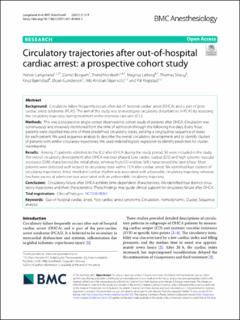| dc.contributor.author | Langeland, Halvor | |
| dc.contributor.author | Langeland, Halvor | |
| dc.contributor.author | Bergum, Daniel | |
| dc.contributor.author | Nordseth, Trond | |
| dc.contributor.author | Løberg, Magnus | |
| dc.contributor.author | Skaug, Thomas | |
| dc.contributor.author | Skaug, Thomas Renhult | |
| dc.contributor.author | Bjørnstad, Knut | |
| dc.contributor.author | Bjørnstad, Knut | |
| dc.contributor.author | Gundersen, Ørjan | |
| dc.contributor.author | Skjaervold, Nils Kristian | |
| dc.contributor.author | Klepstad, Pål | |
| dc.date.accessioned | 2021-09-24T06:03:19Z | |
| dc.date.available | 2021-09-24T06:03:19Z | |
| dc.date.created | 2021-09-20T14:38:29Z | |
| dc.date.issued | 2021 | |
| dc.identifier.citation | BMC Anesthesiology. 2021, 21 (1), 1-11. | en_US |
| dc.identifier.issn | 1471-2253 | |
| dc.identifier.uri | https://hdl.handle.net/11250/2781239 | |
| dc.description.abstract | Background: Circulatory failure frequently occurs after out-of-hospital cardiac arrest (OHCA) and is part of postcardiac arrest syndrome (PCAS). The aim of this study was to investigate circulatory disturbances in PCAS by assessing the circulatory trajectory during treatment in the intensive care unit (ICU). Methods: This was a prospective single-center observational cohort study of patients after OHCA. Circulation was continuously and invasively monitored from the time of admission through the following fve days. Every hour, patients were classifed into one of three predefned circulatory states, yielding a longitudinal sequence of states for each patient. We used sequence analysis to describe the overall circulatory development and to identify clusters of patients with similar circulatory trajectories. We used ordered logistic regression to identify predictors for cluster membership. Results: Among 71 patients admitted to the ICU after OHCA during the study period, 50 were included in the study. The overall circulatory development after OHCA was two-phased. Low cardiac output (CO) and high systemic vascular resistance (SVR) characterized the initial phase, whereas high CO and low SVR characterized the later phase. Most patients were stabilized with respect to circulatory state within 72 h after cardiac arrest. We identifed four clusters of circulatory trajectories. Initial shockable cardiac rhythm was associated with a favorable circulatory trajectory, whereas low base excess at admission was associated with an unfavorable circulatory trajectory. Conclusion: Circulatory failure after OHCA exhibits time-dependent characteristics. We identifed four distinct circu‑latory trajectories and their characteristics. These fndings may guide clinical support for circulatory failure after OHCA. Trial registration: ClinicalTrials.gov: NCT02648061 | en_US |
| dc.language.iso | eng | en_US |
| dc.publisher | BioMed Central Ltd. | en_US |
| dc.rights | Navngivelse 4.0 Internasjonal | * |
| dc.rights.uri | http://creativecommons.org/licenses/by/4.0/deed.no | * |
| dc.title | Circulatory trajectories after out-of-hospital cardiac arrest: a prospective cohort study | en_US |
| dc.type | Peer reviewed | en_US |
| dc.type | Journal article | en_US |
| dc.description.version | publishedVersion | en_US |
| dc.source.pagenumber | 1-11 | en_US |
| dc.source.volume | 21 | en_US |
| dc.source.journal | BMC Anesthesiology | en_US |
| dc.source.issue | 1 | en_US |
| dc.identifier.doi | 10.1186/s12871-021-01434-2 | |
| dc.identifier.cristin | 1936135 | |
| cristin.ispublished | true | |
| cristin.fulltext | original | |
| cristin.qualitycode | 1 | |

